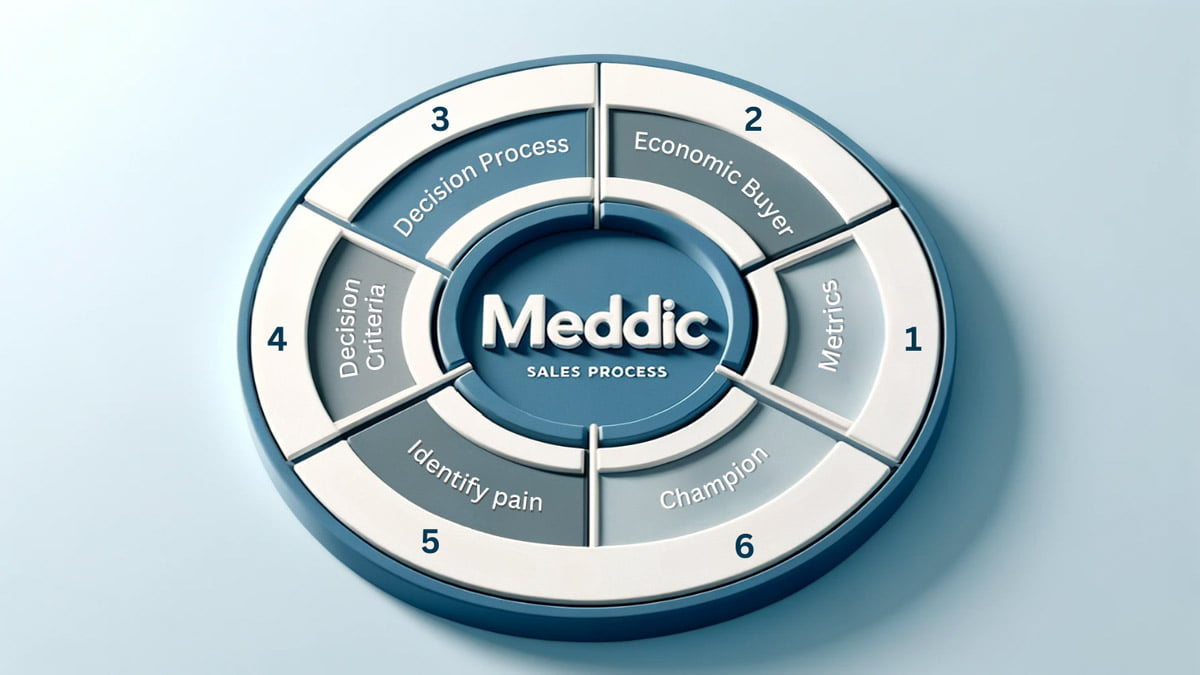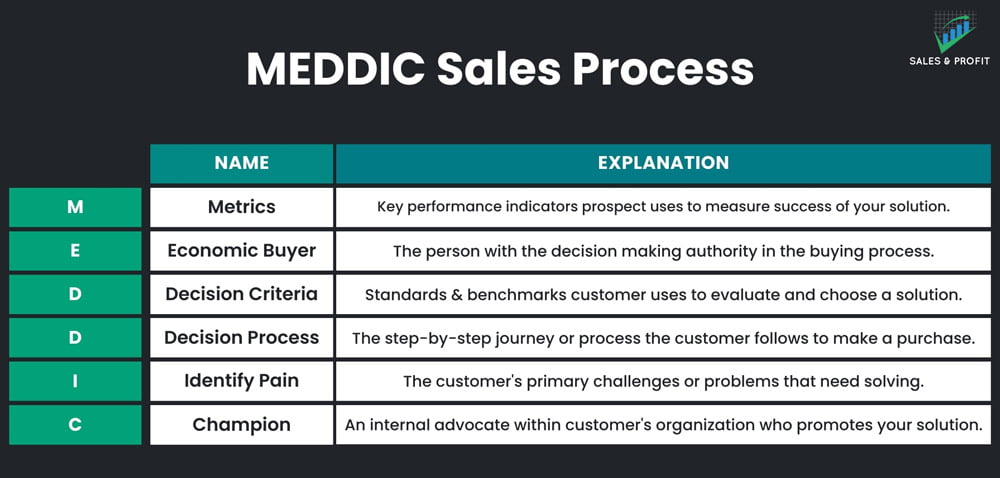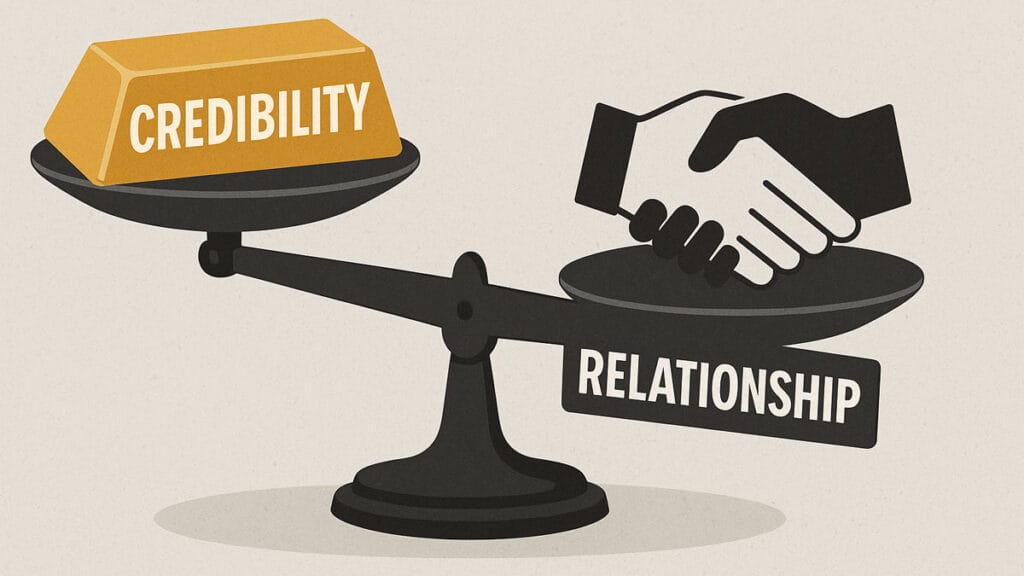Table of Contents
What is MEDDIC Sales Process?
Click on the image to enlarge
MEDDIC is sales process that focuses on qualifying the prospects that has the highest chance of purchasing your solution
MEDDIC was first developed Jack Napoli and Dick Dunkel at PTC in the early 1990s.
At PTC, MEDDIC helped triple sales their from $300 million to $1 billion in just four years.
Here’s what MEDDIC stands for:
- Metrics: This is all about the numbers. What does success look like to your customer? How do they measure it? Knowing this helps you tailor your solution to their specific goals.
- Economic Buyer: This is the person with the wallet – the one who makes the final call on the purchase. Identifying them early on is key to a streamlined sales process.
- Decision Criteria: What boxes does your solution need to tick for the customer? Understanding their criteria for making decisions is crucial to align your pitch.
- Decision Process: Every customer has their own steps and stages in making a decision. Grasping this process helps you align your sales strategy accordingly.
- Identify Pain: What challenges is your customer-facing? Identifying these pain points means you can directly address how your solution helps.
- Champion: This is your inside advocate – someone within the customer’s organization who believes in the value of your solution and can sway others.
MEDDIC helps sales professionals navigate complex sales scenarios by focusing on these critical areas, ensuring a more targeted and effective sales approach.
Let’s cover the MEDDIC questions to know if the prospect is a right fit.
Test Your Knowledge of MEDDIC Process
50+ MEDDIC Discovery Questions to Qualify Your Prospects Better
1. Metrics
Alrighty, let’s jump into the first part of MEDDIC: Metrics.
Think of Metrics like a scoreboard in sports. It’s all about understanding how your customer keeps score of their success.
What numbers are they trying to hit? What does a big win look like for them?
When we know this, we can tailor our pitch to show how our product or service will help them hit that home run.
1. What key performance indicators (KPIs) are most important for your team?
This question helps you understand what matters most to your customer. Are they looking to boost sales, increase efficiency, or improve customer satisfaction? Once you know their KPIs, you can show how your solution directly impacts these areas.
2. How much of an impact on [metric] do you need to see to consider this project successful?
Every company has its own way of measuring success. Quantifying desired impact sets clear expectations and helps shape solution recommendations.
3. What KPIs or metrics do you use to measure the performance of [relevant area]?
Understanding their key metrics provides insight into what they value and how they define success. This helps frame the value of your solution.
4. What are the biggest challenges you face in consistently meeting your [X metrics]?
This question identifies the pain points and roadblocks that your solution can potentially overcome. This also demonstrates your focus on solving their actual problems, not just selling a product
5. Which KPIs are most impacted by the challenges you’re facing?
This question connects the dots between their challenges and the financial health of the company. It helps you show how your solution can have a positive impact on their bottom line.
6. Looking ahead, what goals do you have for the next quarter/year?
Understanding their future goals can help you position your product as a long-term solution, not just a quick fix.
7. What is preventing you from improving [X] KPIs?
Highlights the current challenges, pain points, and root causes tied to key KPIs. You can tailor your pitch highlighting how your solution can overcome those challenges and help them achieve those KPIs.
8. Are there any initiatives focused specifically on optimizing [metric Z]? What KPIs track progress?
This question will uncover any current and planned improvement programs tied to key metrics.
9. In your view, what areas are currently underperforming and need the most attention?
By identifying areas of underperformance, you can tailor your solution to address these specific areas.
10. How does improving these metrics impact your team/department/company?
This shows you the bigger picture. How does changing these metrics affect the overall health and success of their team or company? It helps you position your solution as a key part of their larger strategy.
Want to Solve Sales Challenges That's Affecting Your Revenue Growth?
Request a 100% free “no obligation” sales consulting call where we will understand your current sales challenges and help you with proven methods to boost your sales and grow your revenue.
(Already 100+ B2B companies have seen growth in their sales and revenue)
2. Economic Buyer
Now, let’s talk about the Economic Buyer in the MEDDIC.
This is the person who holds the purse strings
They’re the one who can give your project the green light or stop it in its tracks.
So, it’s super important to know who this person is and what makes them tick.
Let’s get into how to find and impress this key player.
11. Who will be making the final decision on this investment?
This straight-to-the-point question identifies the key decision-maker. You need to know who you should really be impressing with your pitch.
12. Can you walk me through the approval process for a purchase like this?
This gives you a roadmap of the buying process, including who’s involved at each stage and what their roles are. This helps to map the decision-making landscape and identifies key influencers.
13. What are the top priorities for the decision-makers when evaluating solution like this?
Understanding the priorities of the decision-maker helps you tailor your pitch to address their specific concerns and interests.
14. How does the economic buyer typically measure the return on investment (ROI) of new solutions?”
This reveals their financial expectations and preferred metrics for success. It will allow you to quantify your value proposition in their language and demonstrate tangible ROI.
15. In past decisions of this nature, what factors influenced the final approval?
This helps you understand the decision-making patterns and preferences, guiding you to shape your proposal accordingly.
16. Does the economic buyer have any specific challenges or goals that we should be aware of?
This question shows that you’re considerate of the buyer’s unique situation, allowing you to connect your solution to their personal or departmental goals.
17. How does the economic buyer typically like to receive information (reports, presentations, demos)?
Tailoring your communication style to the buyer’s preference can make your proposal more impactful and easier for them to digest.
18. What’s the best way to present our solution’s value to the decision maker?
This question helps you understand how to effectively communicate the value of your solution in a way that resonates with the decision-maker.
19. Has the economic buyer been involved in similar purchasing decisions before?
If they have, they might have a set expectation or approach. If they haven’t, you might need to provide more detailed explanations or comparisons.
20. What are the economic buyer’s long-term strategic goals, and how can our solution align with them?
This demonstrates that you’re not just interested in making a sale but are invested in presenting a solution that aligns with their long-term goals.
3. Decision Criteria
Every company has a checklist when they choose a product or service.
Here you’ll uncover what are criteria’s affect your prospect’s decision making process.
It can be price, features, integration, ease of use and may more.
Understanding your prospect’s decision criteria helps you align your sales pitch according to the prospect’s needs and goals.
Her are the questions to uncover Decision Criteria
21. What are the top 3-5 criteria you typically use to evaluate potential solutions like ours?
This question lays the groundwork. It helps you understand the must-have requirements your solution needs to meet for getting considered.
22. Are there specific compliance or technical requirements that need to be met?
This helps you ensure your solution meets all their technical and regulatory needs, a critical factor in many industries.
23. How do you weigh the importance of different criteria against each other?
Understanding their prioritization framework and identifying potential deal-breakers. It then allows you to ensure your solution clearly addresses their most critical needs.
24. What has been lacking in the solutions you’ve used or considered in the past?
This reveals pain points with previous solutions, allowing you to highlight how your product or service addresses these gaps.
25. Can you describe an ideal outcome or scenario after implementing a new solution?
This dream scenario gives you a target to aim for with your solution, showing how it can turn their ideal into a reality.
26. What weight do cost considerations have in your decision-making process?
Pricing is always a factor. Understanding its importance helps in structuring your offer to fit their budget constraints while still providing value.
27. Are there any specific industry best practices or regulatory requirements the vendor needs to comply on?
Ensures your solution meets all necessary compliance standards and market expectations. It avoids potential roadblocks and positions your solution as compliant and reliable.
28. Are there any internal standards or processes we should be aware of when proposing a solution?
Knowing their internal standards ensures that your proposal is in line with their organizational procedures and policies.
29. What are the short-term and long-term goals you aim to achieve with this solution?
This helps you understand their broader objectives, allowing you to position your solution as a key player in achieving both immediate and future goals.
30. How do you evaluate the potential ROI of a new solution?
This gives insight into their evaluation process and what aspects of ROI are most critical, enabling you to tailor your value proposition accordingly.
4. Decision Process
As the name suggest, decision process are the steps your prospect go through to make a decision of purchase.
There can be a lot of internal process depending on the company to reach to a purchase decision.
Like who all are involved, paperwork, documentation, agreement, pilot run etc.
Just like you’d need a map to reach your destination, understanding the prospect’s decision process is key to guiding them to a successful purchase.
Questions to Explore the Decision Process
31. What are the key steps in your decision-making process?
This is your roadmap. It helps you understand the stages your customer goes through, so you can align your sales strategy accordingly.
32. What are your timelines for implementation?
Timing is everything. Knowing their timeline helps you plan your approach, ensuring you’re providing solutions and information at the right times.
33. Who all are involved in the decision-making process, and what are their roles?
This question helps you identify all the stakeholders. It’s crucial to know who you need to convince and their specific concerns.
34. How has your organization made similar decisions in the past?
Past behaviour often predicts future actions. Understanding their previous decision-making patterns can give you insights into how to approach them this time.
35. Are there any internal deadlines or events that will influence this decision?
This question reveals any external pressures or deadlines that might be driving their decision, helping you prioritize and tailor your pitch.
36. What obstacles or challenges have you faced in making similar decisions before?
Knowing the hurdles they’ve encountered before allows you to proactively address these challenges in your proposal.
37. How do you typically communicate and get approvals from different stakeholders?
This helps you understand their internal communication dynamics, allowing you to provide the right information in a format that aids their discussion and decision.
38. After vendor selection, what internal sign-offs are required before contracting?
This will give you insights on post-evaluation approval chain and any additional decision makers involved.
39. Are there any external factors or events that could impact the timeline or decision-making process?
This Identifies potential delays or changes in direction and allows you to adapt your approach.
40. How do you prioritize different aspects of the solution during the decision process?
Understanding their priorities lets you highlight those aspects of your solution that are most critical to them, aligning your offering with their key decision factors.
5. Identifying Pain
Alright, moving forward in our MEDDIC methodology, we hit a crucial spot: Identifying Pain.
According to me this is the most important part in the process.
Every prospect has challenges or ‘pain points’ they’re facing, and your job is to uncover these and show how our solution can make their lives easier.
Let’s figure out how to ask the right questions to bring these pain points to light.
Questions to Uncover Pain Points
41. What are the biggest challenges you and your team currently face in [area relevant to your solution]?
This is your starting point. It’s an open-ended question that invites the client to share their current struggles, giving you a clear idea of where they need help.
42. How does this challenge affect your day-to-day operations?
Understanding the daily impact of these challenges helps you empathize with the client and tailor your solution to their everyday needs.
43. What inefficiencies or bottlenecks exist with your current solutions/process?
Reveals workflow frustration that translates into productivity drag and opportunity cost.
44. What solutions have you tried in the past, and why didn’t they work?
Knowing what they’ve tried and why it failed helps you position your solution as a better alternative, addressing past shortcomings.
45. What would the ideal solution and the outcome look like for you?
This helps you understand their perfect scenario, allowing you to align your solution with their ideal outcome as closely as possible.
46. What are the short-term and long-term impacts of these challenges?
Recognizing the immediate and future consequences of their pain points can help you demonstrate the urgency and long-term value of your solution.
47. What is the financial impact of these challenges on your business?
Linking their challenges to financial outcomes makes the need for a solution more tangible and urgent.
48. Do these challenges affect your customers or clients in any way?
This expands the conversation to the broader impact on their business, including customer satisfaction and retention.
49. What has prevented you from solving these issues so far?
Understanding the barriers they’ve faced gives you insights into potential objections or limitations they perceive, which your solution must overcome.
50. What are the key features or capabilities that you think would solve these challenges?
This question gets the client to articulate their needs, which helps you highlight those specific features in your solution that address their problems.
6. Champion
Think of a Champion as your inside Advocate, the person in the customer’s organization who really believes in your solution and will bet for you.
You develop a champion over the course of time while working with an account.
There are 3 criteria that define a champion :
- They have the power and influence
- They would be selling internally for you
- They need to have a vested interest in your success
Questions to Ask Your Champion
51. What specific concerns or objections have other decision-makers raised about our solution?
This question helps you anticipate and prepare for potential objections, allowing you to address them proactively in your pitch or proposal.
52. Can you share insights on the organization’s budget cycle or procurement process that might affect the purchase?
Understanding the company’s budgeting and procurement timelines can help you time your proposal more effectively.
53. What’s the best way to tailor our solution to meet the priorities of your senior management?
Tailoring your solution to align with top management’s priorities can significantly increase the likelihood of getting their buy-in.
54. Are there any upcoming internal events or changes that might impact the decision-making process for our solution?
Being aware of internal events or changes (like leadership shifts or policy updates) helps you understand possible shifts in priorities or delays in decision-making.
55. What kind of data or proof is most effective in convincing your team about the ROI of our solution?
This helps you provide the most compelling and relevant data to support the value proposition of your solution.
56. Who are the influencers within the organization that we should focus on, and what are their key concerns?
Identifying and addressing the concerns of other influential people in the organization can help in building broader support for your solution.
57. How does our solution align with the company’s strategic goals or initiatives?
This question helps ensure that your solution is positioned as not just a tool, but a strategic asset that aligns with the company’s broader objectives.
58. What internal communication strategies have been effective in the past for introducing new solutions like ours?
Understanding effective communication strategies within the organization can help in crafting a more persuasive message about your solution.
59. What are the personal goals of key stakeholders that our solution can help achieve?
Aligning your solution with the personal goals of key stakeholders can make your solution more appealing and relevant to them.
60. Is there any historical context or past experiences within the company that we should be aware of when positioning our solution?
Knowing the company’s history with similar solutions, either positive or negative, allows you to frame your solution in a way that resonates with their past experiences.
Wrap Up
Having a list of so many questions can be overwhelming for a salesperson.
One might get easily confused about what questions should be asked and when.
Timing is key in sales conversations.
Asking the right question at the wrong time can be as ineffective as not asking it.
That’s where having effective sales training programs to implement frameworks like MEDDIC and SPIN in your sales team.
Sales & Profit offers sales training programs in India for companies looking to implement proven methodologies and take their sales team to the next level.





